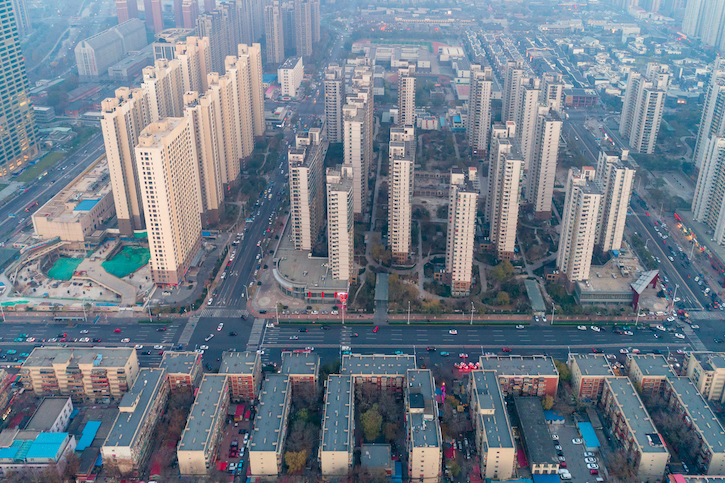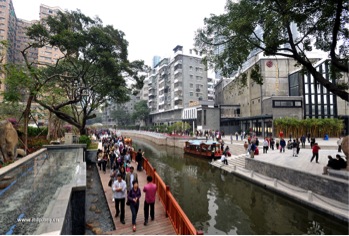By CC Huang, Energy Innovation LLC

On February 21, China’s State Council and the Communist Party’s Central Committee released a new set of guidelines (English coverage) for strengthening urban planning and development. These guidelines were borne out of recommendations from the Central Urban Work Conference this past December reflecting the nation’s new emphasis on urban sustainability. The last such meeting was held in 1978, when China’s cities were home to less than 20 percent of its population. By contrast, that number today is 57 percent.
This announcement represents a major step forward for urban development in China. For the past few decades, city planning was based on a car-dependent, Soviet model dominated by superblocks, wide roads, and single-use districts. By comparison, the new guidelines prioritize walking and public transit options over car use, preserve historical and cultural characteristics, and grow cities only within the means of their natural resources.
In 2008, for the first time in human history, more than half of the global population was living in urban areas and the United Nations predicts two-thirds of the world’s population, about six billion people, will be city dwellers by 2050. As the world’s most populous nation, China’s urban development will set the tone as urban populations continue to grow worldwide.
The comprehensive principles included in China’s new guidelines range widely in scale, covering a city’s entire geographic boundary down to its streets, blocks, and buildings. They also offer guidance on municipal water, waste, and energy systems, which are important at all scales. Below, we elaborate on five of the key principles included in the guidelines:
1. “Narrow roads, dense street networks”
This line has become a popular phrase for Chinese media to summarize an important element of the State Council’s new guidelines: smaller blocks. China’s cities are currently dominated by superblocks—enormous (often 500 meters long or more) expanses of single-use lots, divided by multi-lane streets with wide, dangerous intersections. This type of environment deters pedestrian activities and strongly caters to the automobile, but new focus on smaller blocks will significantly improve pedestrian experiences by promoting safer, more pleasant, more efficient routes. By improving the pedestrian environment, small blocks also reduce car usage and, thus, air pollution.
2. Enforcing urban growth boundaries
Despite their large populations, Chinese cities are often less dense than they should be, promoting inefficient resource use. Urban growth boundaries are necessary in this regard to promote compact development and preserve peripheral land for agriculture. The new guidelines urge implementing urban growth boundaries based on the ecological “carrying capacity” of the region and prioritizing regeneration and redevelopment in existing urban space. To enforce this commitment to space preservation, the new guidelines call for use of remote sensing technology to ensure that existing growth boundaries are enforced.
3. Expanding public (and green) space
The new guidelines specify all residents have improved access to public amenities, particularly public green space. Ideally, all residents will have access to public green space, entailing construction of new public squares, parks, pedestrian paths, and other public spaces encouraging cultural and physical activities while fostering a greater sense of community. Under this effort any illegally occupied public space would be reallocated back to public use.

In an effort to expand public space, China’s new guidelines also urge opening up existing gated communities, sparking a fierce debate between gated community dwellers and the government. In recent years, China’s gated communities have gained in popularity due to their perceived safety (though there is no conclusive evidence gated communities are safer than open neighborhoods) and privacy, at the expense of their contribution to traffic congestion and inefficient land consumption. China’s Supreme Court is currently challenging this policy to open up gated communities, based on the country’s property laws.
4. Increasing use of public transit
While China has built a slew of new subway lines in the past decade, the new urbanization guidelines emphasize a diverse mix of public transit options. Public transit, when done right, offers the cheapest, cleanest, most convenient mode of transportation for distances beyond walking or biking range. The new guidelines call for megacities (with populations of 10 million or more) to have a public transit mode share of 40 percent, big cities (with populations of five to 10 million) to have a public transit mode share of 30 percent, and small- and medium-sized cities (with populations of 500,000 to five million) to have a public transit mode share of 20 percent or more, all by 2020.
5. Focusing on historical preservation and city character
Many fear China’s cities, dominated by concrete skyscrapers and colossal commercial centers, are beginning to look and feel like any other generic city. The new guidelines have an entire section devoted to cultivating city character and call for cities to focus on cultural continuity, preserving old buildings, and revitalizing older urban areas. Part of this cultural and historical preservation involves the rejection of architecture and design styles blindly replicating large, western, bland features, in favor of integrating “suitable,” “economical,” “green,” and “aesthetic” characteristics.
Learn more:
- Read “Green and Smart Urban Development Guidelines”, a product of collaboration between Energy Innovation, Energy Foundation China, and China Development Bank Capital (CDBC), the largest sovereign financier of urbanization projects in China, to help steer CDBC’s urbanization investments. In particular, the project’s 12 green guidelines, the dozen key development features that constitute sustainable cities, are highly aligned with the principles put forth in the State Council last week.
- Do you work on issues related to sustainable urbanization? Learn more about the Paulson Institute’s Prize for Cities of the Future, awarded annually to a project in China that models best-practices for the country’s sustainable urbanization and economic transition. Stay tuned for 2016 submissions to open this summer.
CC Huang is a policy analyst at Energy Innovation. The full version of this blog can be read here.


